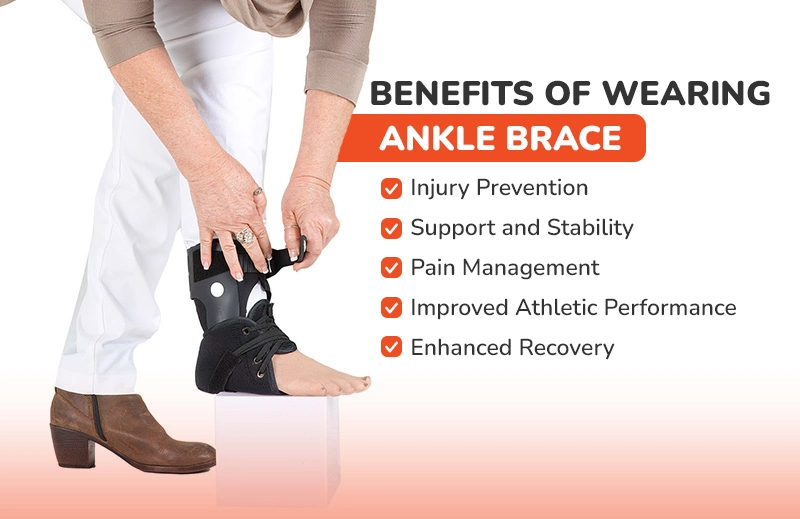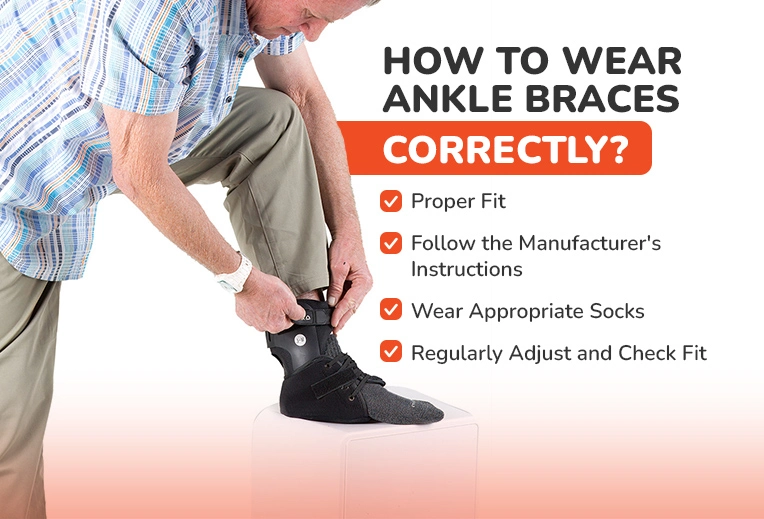Understanding Ankle Braces: Uses, Benefits, and Types
Ankle injuries are a common setback for athletes, fitness enthusiasts, and even those leading a moderately active lifestyle. The road to recovery can be long and fraught with the risk of re-injury, making effective preventive measures and support mechanisms essential. Enter the world of ankle braces, a simple yet powerful tool designed to safeguard one of the most vulnerable joints in the body. This article delves into the uses, benefits, and various types of ankle braces, offering valuable insights for anyone looking to enhance their mobility, prevent injuries, or support the healing process of an already injured ankle. Whether you’re an athlete looking to maintain peak performance or someone recovering from an ankle mishap, understanding the role of ankle braces can be a game-changer in your health and fitness journey. Explore how these supportive devices can help you stay active, safe, and injury-free.
Introduction to Ankle Braces
Ankle braces, often considered a staple in athletic and medical communities, are designed garments that encircle the ankle to offer a blend of protection, support, and stability. Their primary role is multifaceted: to shield the ankle from the common yet debilitating sprains that occur during high-impact activities, to offer a supportive embrace during the delicate phases of injury recovery, and to act as a preventative barrier against the recurrence of ankle-related injuries. The essence of an ankle brace lies in its ability to mimic the support structure of the ankle’s natural ligaments. Doing so reduces the undue strain and stress on these ligaments during physical activities, minimizing the risk of overextension or tears. For athletes who constantly push their boundaries, ankle braces are an indispensable ally, providing the confidence to perform at peak levels without the looming fear of injury.
Beyond professional sports and athletic endeavors, ankle braces hold significant value for individuals recuperating from ankle injuries. The road to recovery can often be a slow and painstaking process, where the risk of re-injury remains high. Ankle braces offer a strategic level of compression and support, facilitating a safer, more controlled environment for healing tissues to regenerate and strengthen. This compression stabilizes the joint and enhances blood circulation to the injured area, accelerating the healing process.
The Purpose of Ankle Braces
The role of ankle braces extends beyond physical support; they are a critical component in a comprehensive approach to ankle health and safety. At their core, ankle braces are engineered to provide stability to the ankle joint, a crucial factor in ankle health management’s prevention and recovery phases. This stability is especially vital in activities that involve quick pivots, jumps, or runs, where the ankle is subjected to forces that could potentially lead to sprains or more severe injuries. By securely enveloping the ankle, braces reinforce the joint’s natural movements, thereby reducing the likelihood of movements that could result in injury.
Injury reduction is another paramount purpose of ankle braces. The stark reality is that ankle injuries are common and can lead to prolonged periods away from sport or activity, significantly impacting an individual’s quality of life. Ankle braces are preventive, offering a protective shield against twists and turns that often result in sprains or fractures. For individuals with a history of ankle injuries, this protection is invaluable, as it significantly lowers the risk of re-injury by providing a controlled environment for the ankle to move within safe limits.
Types of Ankle Braces
The landscape of ankle braces is rich and diverse, catering to various needs, preferences, and specific conditions. Each type of ankle brace is meticulously designed to address different levels of support, protection, and comfort, making an ankle brace an essential consideration for optimal ankle health and performance.
1. Sleeve Braces
Sleeve braces, characterized by their simplicity and ease of use, are crafted from stretchable, breathable materials such as neoprene or spandex. These braces slip on over the foot, snugly encasing the ankle in a comfortable, compressive fabric. Ideal for minor sprains and injuries, sleeve braces provide a basic level of support, enhancing proprioception (the sense of joint position) while still allowing for a full range of motion. They are particularly favored for their lightweight design and unobtrusive fit, making them a popular choice for daily wear among those seeking mild to moderate ankle stabilization.
2. Strap Braces
Strap braces take the concept of support a notch higher by incorporating adjustable straps that crisscross over the ankle, offering enhanced stability and customizable compression. These straps mimic the action of taping the ankle, a traditional method of injury prevention and support among athletes. The strategic placement of the straps allows users to adjust the tightness and support level according to their specific needs, providing targeted protection against lateral and medial ankle movements that could lead to sprains and strains. Strap braces are a go-to option for individuals returning to activity post-injury or requiring additional support in high-impact sports.
3. Lace-Up Braces
Lace-up braces offer a more traditional, customizable fit, featuring a lace-up design that allows for precise adjustments in tightness and compression. Constructed from durable fabric, these braces provide higher support and stability by snugly fitting around the ankle and often extending slightly above and below the joint. The lace-up mechanism ensures a secure, tailored fit, reducing the risk of the brace shifting during activities. This brace is particularly beneficial for individuals recovering from moderate to severe ankle injuries, offering substantial support while permitting mobility.
4. Hinged Braces
At the pinnacle of ankle brace technology are the hinged braces, designed for those requiring the utmost protection and restriction of movement. Featuring rigid supports or hinges that run alongside the ankle, hinged braces are engineered to prevent abnormal ankle movements that could lead to re-injury while allowing for the foot’s natural dorsiflexion and plantarflexion (upward and downward movement). These braces are often prescribed following severe sprains, fractures, or surgeries when the ankle needs to be immobilized or when the risk of re-injury is particularly high. Despite their robust construction, modern hinged braces are designed with comfort and mobility in mind, providing users with the confidence to resume daily activities or sports with maximum protection.
Benefits of Wearing Ankle Braces
The benefits of wearing ankle braces extend far beyond mere physical support, touching on preventive health, rehabilitation, and even psychological well-being. These devices are crafted with the understanding that the ankle’s health is pivotal not just to mobility but to maintaining an active, injury-free lifestyle. Let’s delve deeper into the multifaceted advantages of incorporating ankle braces into your health and fitness regimen.

- Injury Prevention: One of the most lauded benefits of ankle braces is their ability to significantly mitigate the risk of ankle injuries, which is especially critical in high-impact sports where the likelihood of sprains, twists, and turns is high. Ankle braces are a physical barrier and support system, reinforcing the ankle’s natural structure and function. By stabilizing the joint and reducing excessive movement that could lead to injury, these braces are invaluable tools for athletes and physically active individuals who seek to prevent the initial occurrence or recurrence of ankle injuries.
- Support and Stability: For those recovering from an ankle injury, the journey back to full health can be arduous and fraught with the risk of setbacks. Ankle braces provide crucial support and stability during this vulnerable period, safeguarding the joint against movements that could hinder recovery. This support is not just physical; it instills confidence in individuals to engage in rehabilitation exercises and gradually return to daily activities, knowing their injured ankle is securely supported.
- Pain Management: The role of ankle braces in managing pain cannot be overstated. By applying gentle compression and restricting detrimental movements, these braces can significantly alleviate pain associated with sprains, strains, and other ankle injuries. The compression helps reduce swelling—a primary source of pain post-injury—while also enhancing blood circulation to the affected area, accelerating the healing process and reducing discomfort.
- Improved Athletic Performance: Athletes often rely on ankle braces for injury prevention and as a performance-enhancing aid. While it might seem counterintuitive, the right ankle brace can empower athletes to perform at their peak without the mental burden of potential injuries. Knowing that their ankles are protected allows athletes to push their limits, make dynamic movements, and improve their performance in competitive and training environments.
- Enhanced Recovery: The immobilization provided by ankle braces plays a pivotal role in recovering from ankle injuries. By limiting the range of motion, these braces allow the injured tissues the time and stability they need to heal effectively. This immobilization is particularly crucial in the early stages of recovery when the ankle is most vulnerable. Furthermore, ankle braces can be adjusted to gradually increase the ankle’s range of motion over time, aligning with the healing process and ensuring that recovery is swift and secure.
Choosing the Right Ankle Brace
When selecting the perfect ankle brace, understanding your specific needs and the various options is crucial. The process involves more than picking the first brace you come across; it requires thoughtful consideration of several key factors to ensure that you choose a brace that fits well and provides the necessary support and protection.
1. Intended Use and Activity Level
First and foremost, consider the primary reason for wearing an ankle brace. Are you looking to prevent injuries during sports activities or need support during recovery? The intensity and nature of your activities play a significant role in determining the type of ankle brace that’s best for you. A more robust brace with additional support might be necessary for high-impact sports, while for daily wear or low-impact activities, a lighter, more flexible brace could suffice.
2. Severity of Condition
The severity of any pre-existing ankle conditions or injuries is another critical consideration. A compression sleeve or a strap brace may offer enough support for mild sprains. In contrast, severe injuries or conditions requiring significant stabilization might necessitate a lace-up or hinged brace. Assessing the level of support needed to adequately protect and aid your ankle is paramount in making the right choice.
3. Comfort and Material
Comfort is key when selecting an ankle brace, as it directly impacts your willingness and ability to wear it as needed. Look for breathable materials to prevent excessive sweating and ensure the brace is made from skin-friendly fabrics to avoid irritation. Additionally, consider the brace’s weight and bulkiness, especially if you plan to wear it during athletic activities or for extended periods.
4. Design and Adjustability
The design and adjustability of the ankle brace are also important factors. Some braces offer adjustable straps or laces that allow for a customized fit, which can be particularly beneficial as swelling decreases or your needs change over time. A well-designed brace should align with your foot and ankle’s contours, providing support without unnecessarily impeding movement.
How to Wear Ankle Braces Correctly?
Wearing an ankle brace correctly is as vital as choosing the right one. Incorrect application can reduce the brace’s effectiveness and sometimes lead to further discomfort or injury.

1. Proper Fit
Ensure that the ankle brace fits snugly around your ankle and foot. It should be tight enough to offer support and compression but not so tight that it cuts off circulation or causes discomfort. Consulting with a healthcare professional can provide clarity and assurance if you’re unsure about the fit.
2. Follow the Manufacturer’s Instructions
Each ankle brace comes with specific instructions for wearing and adjusting it. These guidelines are designed to maximize the brace’s effectiveness and should be followed carefully. This includes positioning the brace, securing any straps or laces, and any recommended wearing schedules.
3. Wear Appropriate Socks
Wear a thin, breathable sock underneath the ankle brace to enhance comfort and prevent skin irritation. This can also help adjust the brace’s fit and prevent it from sliding during movement.
4. Regularly Adjust and Check Fit
Especially during the initial use period, check the ankle brace’s fit regularly and adjust as necessary. Swelling and activity levels can change how your brace fits, so it’s important to ensure it remains snug and supportive without being overly tight.
By carefully considering the selection and proper application of an ankle brace, individuals can significantly benefit from its added support and protection. Whether for prevention, recovery, or performance enhancement, the right ankle brace, worn correctly, is a valuable asset in maintaining ankle health and mobility.
Read More: Ankle Braces: Types, Uses, and Choosing the Right Fit
Caring for Your Ankle Brace
Proper care and maintenance are essential to ensure your ankle brace remains in optimal condition, providing the support and protection you need. An ankle brace that is well-cared-for extends its lifespan and maintains its functionality and hygiene. Here are some detailed guidelines for caring for your ankle brace:
1. Cleaning Your Ankle Brace
Regular cleaning is crucial to prevent the buildup of sweat, bacteria, and odors. Most ankle braces are suitable for hand washing with mild soap in lukewarm water. It’s important to gently scrub the brace to remove dirt and sweat without stretching or damaging the material. After washing, thoroughly rinse the brace to remove soap residue.
2. Drying Your Ankle Brace
After washing, gently press out any excess water and let the bracing air dry. Lay it flat in a well-ventilated area out of direct sunlight. Avoid using high temperatures to dry the brace, such as radiators, dryers, or direct sunlight, as high heat can degrade the elasticity and integrity of the material, reducing the brace’s effectiveness and comfort.
3. Regular Inspection and Maintenance
Regularly inspect your ankle brace for signs of wear and tear, such as stretched material, loose fittings, or weakened support structures. If you notice any damage, it may be time to replace the brace to ensure you continue to receive the proper support. Additionally, if your brace has adjustable straps or laces, check them periodically to ensure they’re in good working order and adjust them as needed for the best fit.
4. Proper Storage
Store your ankle brace in a cool, dry place when not in use. Properly storing the brace when not in use prevents unnecessary exposure to the elements and potential damage. Folding or rolling the brace loosely, rather than crumpling it, helps maintain its shape and functionality.
Ankle Braces for Athletes and Active Individuals
For athletes and those regularly engaged in physical activity, ankle braces are invaluable for injury prevention and support. The demands placed on the ankles during high-impact and repetitive movements can significantly increase the risk of injuries. Here’s how ankle braces serve as a beneficial support system:
1. Enhanced Injury Prevention
The support provided by ankle braces helps stabilize the joint, reducing the risk of twists, rolls, and sprains common in sports and physical activities. This preventative measure is especially crucial for athletes who have previously experienced ankle injuries, as they are at a higher risk of subsequent injuries.
2. Support During High-Impact Activities
High-impact sports and activities involving jumping, running, or rapid direction changes significantly strain the ankles. Ankle braces distribute the stress more evenly across the joint, providing additional support that can help prevent overuse injuries and strains.
3. Confidence and Performance
Wearing an ankle brace can also boost an athlete’s confidence, knowing their ankle is protected. This psychological benefit allows athletes to perform at their best, focusing on their sport without being hindered by fear of injury.
4. Customization for Specific Activities
Different sports and activities may require different levels of support. The availability of various ankle braces allows athletes and active individuals to choose a brace that best suits their specific needs, ensuring they receive the appropriate level of support without sacrificing performance or comfort.
Incorporating ankle braces into the routine of athletes and physically active individuals not only aids in preventing injuries but also supports overall performance and confidence. Proper care and selection of an ankle brace tailored to specific activities further enhance these benefits, making ankle braces a key component of a proactive approach to ankle health and safety.
Conclusion
Ankle braces are valuable for injury prevention, recovery, and support. By understanding the different types, benefits, and proper use of ankle braces, individuals can make informed decisions about their ankle health and ensure they get the appropriate support. By focusing on the simplicity of language and straightforwardly presenting the information, this article aims to be highly readable and informative for anyone interested in learning about ankle braces.



